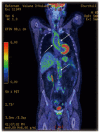Giant cell arteritis: Current treatment and management
- PMID: 26090367
- PMCID: PMC4468893
- DOI: 10.12998/wjcc.v3.i6.484
Giant cell arteritis: Current treatment and management
Abstract
Glucocorticoids remain the cornerstone of medical therapy in giant cell arteritis (GCA) and should be started immediately to prevent severe consequences of the disease, such as blindness. However, glucocorticoid therapy leads to significant toxicity in over 80% of the patients. Various steroid-sparing agents have been tried, but robust scientific evidence of their efficacy and safety is still lacking. Tocilizumab, a monoclonal IL-6 receptor blocker, has shown promising results in a number of case series and is now being tested in a multi-centre randomized controlled trial. Other targeted treatments, such as the use of abatacept, are also now under investigation in GCA. The need for surgical treatment is rare and should ideally be performed in a quiescent phase of the disease. Not all patients follow the same course, but there are no valid biomarkers to assess therapy response. Monitoring of disease progress still relies on assessing clinical features and measuring inflammatory markers (C-reactive protein and erythrocyte sedimentation rate). Imaging techniques (e.g., ultrasound) are clearly important screening tools for aortic aneurysms and assessing patients with large-vessel involvement, but may also have an important role as biomarkers of disease activity over time or in response to therapy. Although GCA is the most common form of primary vasculitis, the optimal strategies for treatment and monitoring remain uncertain.
Keywords: Disease management; Giant cell arteritis; Glucocorticoids; Immunosuppressive agents; Therapy.
Figures



References
-
- Kale N, Eggenberger E. Diagnosis and management of giant cell arteritis: a review. Curr Opin Ophthalmol. 2010;21:417–422. - PubMed
-
- Jennette JC, Falk RJ. Nosology of primary vasculitis. Curr Opin Rheumatol. 2007;19:10–16. - PubMed
-
- Warrington KJ, Matteson EL. Management guidelines and outcome measures in giant cell arteritis (GCA) Clin Exp Rheumatol. 2007;25:137–141. - PubMed
-
- Gonzalez-Gay MA, Martinez-Dubois C, Agudo M, Pompei O, Blanco R, Llorca J. Giant cell arteritis: epidemiology, diagnosis, and management. Curr Rheumatol Rep. 2010;12:436–442. - PubMed
Publication types
LinkOut - more resources
Full Text Sources
Other Literature Sources
Medical
Molecular Biology Databases
Research Materials

